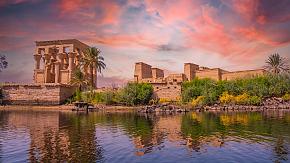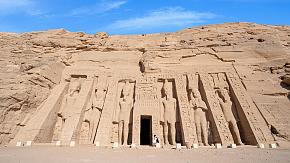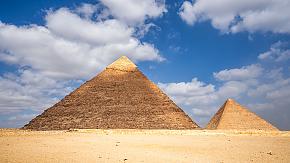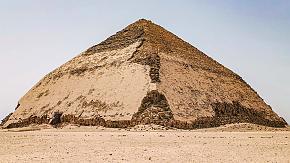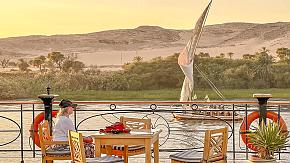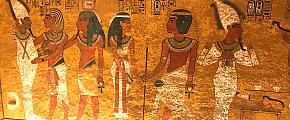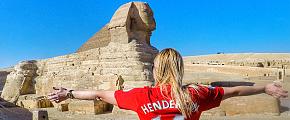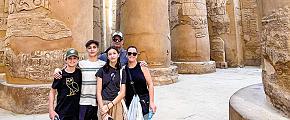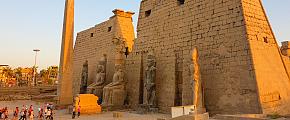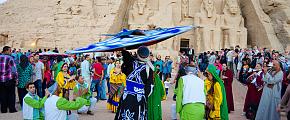UNESCO Tour in Egypt: Visit the World Heritage Sites
From the mysterious pyramids to the magnificent ancient temples, Egypt, with its rich culture and long history, has been regarded as one of the best tourist destinations in the world. Once you land in this mysterious country, there is sure to be much to see, but to get the most out of your journey, do not miss the following UNESCO World Heritage Sites, which could give you an unforgettable experience of this enchanting country.

Pyramids of Giza
The Pyramids of Giza are something that people will always relate to when talking about Egypt. The mysterious pyramids and fascinating stories about ancient pharaohs are eternal attractions to everyone on this planet.
The Giza pyramid complex is located on the west bank of the Nile, about 15km from Cairo. They were built from roughly 2550 to 2490 B.C. as monumental tombs for the ancient pharaohs Khufu, Khafre, and Menkaure.
Once you step into the pyramid complex, you will be totally stunned by the grandeur and beauty of the three pyramids. The Pyramid of Khufu, also called the Great Pyramid, is especially eye-catching for its size and artistic beauty. No wonder it is included as one of the "Seven Wonders of the World". The pyramid was originally 147 meters high, with four equal sides stretching 230 meters. Though stripped of its former limestone outer casings, the pyramid still glistens under the desert sun. Admiring this great architecture, one cannot help but wonder how the ancient Egyptians could have built such a structure without the assistance of modern engineering knowledge and heavy machines. The inside of Giza pyramid is also amazing. Low and zigzagging corridors lead to the King's Chamber, in which lies a huge granite sarcophagus. Though the pharaoh's body is not here, the intricate design and dark environment have all shed a color of myth on the Great Pyramid.
Another amazing part of the pyramid complex is the Great Sphinx near the Pyramid of Khafre. Carved out of a single piece of limestone, the Sphinx resembles a human face but has the body of a recumbent lion. The mythological creature is about 20 meters high and 73 meters long, facing from west to east towards the rising sun, in line with the ancient Egyptians' belief in the power of the sun. This powerful image of the Great Sphinx demonstrated its role as a great guardian of the Pyramid of Khafre.
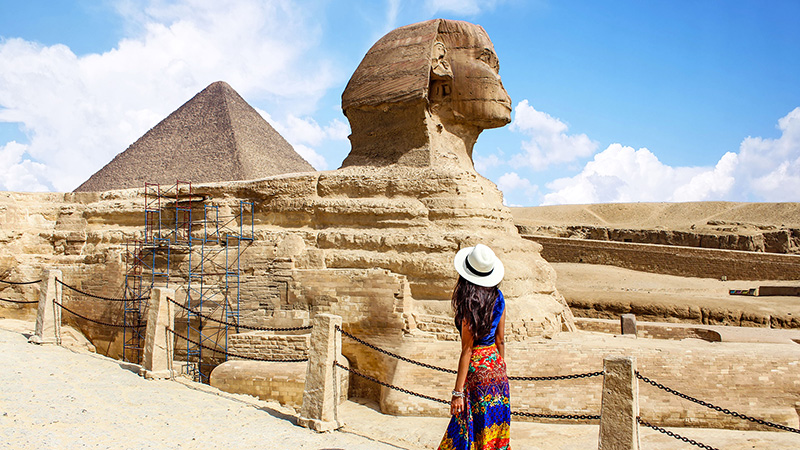 Pyramid and Sphinx
Pyramid and Sphinx
Karnak Temple
The Karnak Temple is such a fantastic place that you should never miss it whenever you are in Egypt. As the largest temple complex in Egypt and one of the largest in the world, Karnak covers an area of 247 acres. It was dedicated to the god Amun - the god of sun and air, the god Mut - the mother goddess, and the god Montu - the god of the moon. The temple complex consists of three parts, the precincts of Amun, Mut, and Montu.
Amun's precinct is the largest and most beautiful part of Karnak. particularly the Great Hypostyle Hall. This magnificent hall is made up of 134 huge columns, with the highest 12 pillars reaching about 21 meters, and the other 122 pillars being about 12 meters high. Each pillar in the hall is massive that several adults standing arm in arm could hardly embrace it. Delicate carvings and reliefs on the columns highlighted pharaohs' military victories or other ritual and festival scenes. The view in this hall is breathtakingly magnificent. Walking through the sky-high pillars, you can feel the grandeur of the hall and the mysterious power of the sun god Amun, especially when the sun lights the hall up through huge natural windows created by the contrast in height between the central land surrounding the pillars.
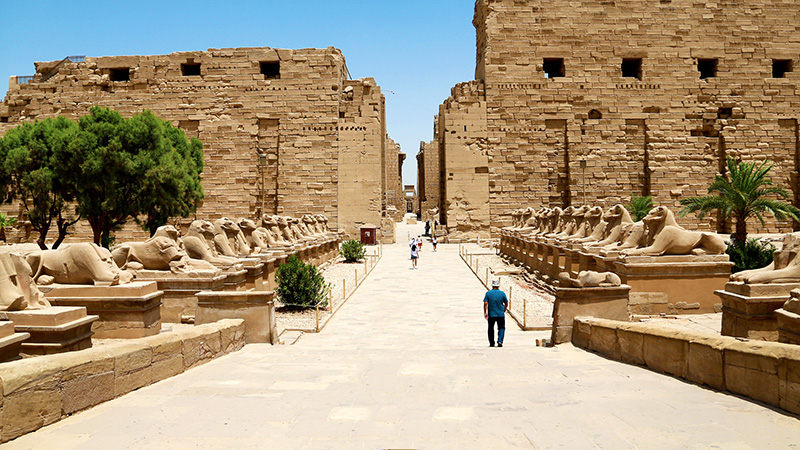 The Karnak Temple
The Karnak Temple
Valley of the Kings
In the hills of the arid tract of Luxor lies the Valley of the Kings, the royal tombs for kings of the New Kingdom (C. 1539-1075 BCE). Fearing for the safety of their rich burials, pharaohs of this period adopted an alternative plan for the pyramids: tombs sunk deep into the heart of the mountains. Here in the Valley of the Kings, you may find around 20 kings out of the 62 tombs, from Thutmose I to Ramesses X.
In the valley, all the tombs were secretly designed to avoid looters since a great number of treasures were once buried there with the deceased kings. Tombs were also gorgeous ornaments with special items, beautiful paintings, as well as hieroglyphic texts.
Of all the tombs, KV 17-Seti I is the largest, with multiple passageways and more than a hundred small chambers. As the owner of the tomb, Pharaoh Seti I was a great king who had contributed much to the prosperity of Egypt, his tomb was also grandly built. Exquisite reliefs, and colorful paintings are all over the tomb walls, and one point you can't miss is the intricately carved column depicting Seti I with the goddess Hathor.
KV 11-Ramesses III has another name: "Tomb of the Harpers", coming from a relief of two blind harpists in the side alcove. This tomb is among the best-preserved ones and is really special since the tomb axis shifts after a breakthrough into the chambers of Amenemesses' tomb, which is very uncommon. The decorations in this tomb are wonderful. You may find colorfully painted sunken reliefs depicting traditional ritual texts and Ramesses before the gods, as well as unusual secular scenes showing foreign tributes, such as highly detailed pottery and boats.
KV 62- Tutankhamun is another tomb worth visiting in that it is the most famous one for its intactness. The king's mummy and invaluable treasures were discovered there, including the golden mask that the boy king was wearing.
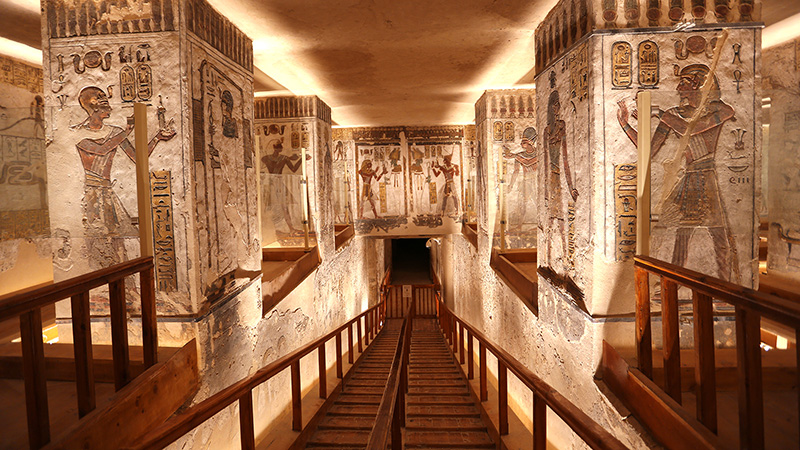 The Valley of the Kings
The Valley of the Kings
Luxor Temple
Located on the upper Nile about 670 km south of Cairo, Luxor Temple is one of the world's largest outdoor museums. It was once the political and religious center of Thebes, the capital of ancient Egypt in the New Kingdom (1550-1070 BCE), with its history dating back to 1400 BCE.
The temple was closely linked with an ancient Egyptian religious celebration, the Opet Festival. In this festival, the gods Amon, Mut and Khons would make a processional journey from Karnak Temple to Luxor Temple to highlight the concept of rebirth. For this reason, the temple was built orienting towards Karnak and once connected with a way bordered by hundreds of sphinxes.
The temple covers an area of 31 hectares and consists of two courts: the court of Ramesses II and court of Amenhotep III. Opposite the sphinxes avenue, at the entrance of the temple, stand a monumental pylon and a 25m high obelisk built by Ramesses II. Two out of the six colossi, about 15 meters high, sit on a pedestal, representing the pharaoh sitting on his throne, guarding the access to the temple. Both courts are highlighted by rows of huge columns with beautiful papyrus capitals. Imposing colonnades, huge statues, and numerous chapels all made the temple a fascinating place.
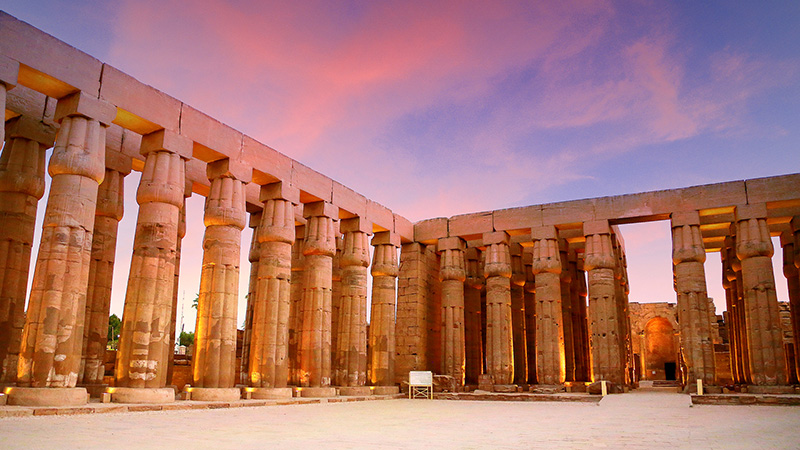 Luxor Temple
Luxor Temple
Philae Temple
Philae Temple was one of the most beautiful and famous archaeological sites in Egypt. Located on the eastern bank of Aswan, the temple honors the deity Isis, goddess of the moon, health, and fertility, as well as the gods Osiris, Isis' husband, and their son Horus.
The history of the temple dates back to around 370 BCE, when King Ptolemy II and his successor Ptolemy III built the major structure of the temple. The interior part was beautifully decorated in later periods under Roman governance.
When you arrive on the boat, a towering pylon with reliefs in front of the entry will lead you to the Isis Temple, the main temple of the complex. In the forecourt, you will see colonnades on both sides and the Birth House on the western side dedicated to Hathor-Isis in honor of the birth of her son Horus. Through the second pylon, you will get into the inner temple, which is led by an eight-columned vestibule. Don't miss the Coptic crosses and Greek inscriptions incised into the walls and reliefs in great detail, telling stories of Isis and the source of the Nile. A number of antechambers will finally lead to the House of Isis, where you can find a granite base that would have held the sacred bark bearing the image of Isis.
Wandering on this quiet and beautiful island, you may hardly imagine that the island was transferred block by block from Philae Island to its current place due to the construction of the High Dam, which would have threatened the subsistence of the temple. Thanks to the efforts of UNESCO and countries taking part in the project have enabled global travelers to enjoy this beautiful architecture today.
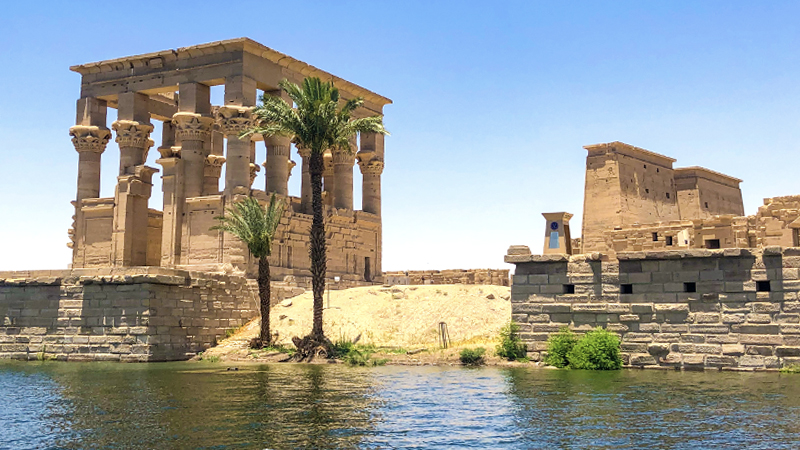 Philae Temple
Philae Temple
Abu Simbel Temples
On two days of every year, the 22nd of February and the 22nd of October, the first rays of the morning sun will enter a grand temple, cross the main hall, and illuminate the innermost statues of Ramesses II. This amazing scene happens at the Abu Simbel Temples.
Sitting on the west bank of Lake Nasser, the temple complex is about 300 km south of Aswan and only 20km north of the border with Sudan. With a history of over 3000 years, the two temples were built by King Ramesses II (reigned from 1279 - 1213), one of the most powerful kings in ancient Egypt.
The main temple, the Great Temple of Abu Simbel, is dedicated to the sun gods Amon-Ra and Re-Horakhte, and the neighboring small one is for Queen Nefertari for the worship of the goddess Hathor, adorned with 10.5m statues of the king and queen.
This place is most well-known for the four imposing seated colossal statues measuring 20m high carved out of rocks in front of the main temple, though one of these collapsed because of an ancient earthquake. The main temple consists of three consecutive halls extending 56 meters into the cliff, decorated with more Osiride statues of Ramesses II and with painted battle scenes of the great king. Colossal standing statues of the king line the main hall, leading to the sanctuary where four deities are worshipped: Amun-Ra, Ra Horakhty, Ptah, and a deified version of Ramesses II.
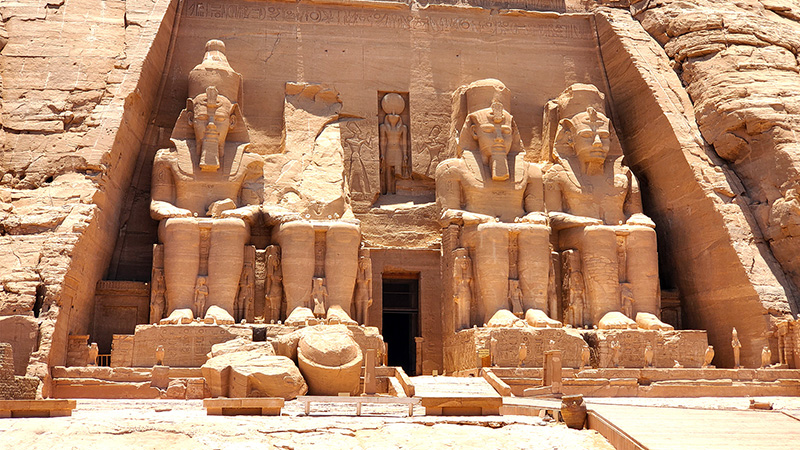 Abu Simbel Temples
Abu Simbel Temples
Historic Cairo (Old Cairo)
Old Cairo is home to magnificent mosques, citadels, hammams and fountains, which are relics of this famous Islamic city whose history dates back to 640 BCE when Islam's armies arrived in Egypt and took over the country.
Walking in the old city, you may find the Mosque of Ibn Tulun, the oldest mosque in Cairo, founded in 879 and famed for its unique architecture; the Saladin Citadel, an Islamic fortification perched on top of a hill in central Cairo, offering some of the most spectacular views over the city; the Mosque of Muhammed Ali, with its twin minarets reaching a height of 84 meters, being the highest across Egypt; as well as one of the oldest streets in Cairo, Muizz Street, which brings together a good number of Islamic architecture. If you are interested in shopping in a typical open-air market in an Arabian city, you cannot miss "Khan El Khalili", Egypt's most important souk, where you can shop, dine or simply immerse yourself in the atmosphere.
Pyramids of Dahshur
30km south of the Giza Pyramids lie the Pyramids of Dahshur, one of the oldest and best-preserved pyramids in Egypt. In total, there are seven pyramids in this place, built from 2613 to 2589 BCE by different pharaohs. The Bent Pyramid and the Red Pyramid, built by Pharaoh Snefru, were the most famous. Other pyramids, such as the Black Pyramid and the White Pyramid, constructed under the rule of Amenemhat III and Amenemhat II were testaments to the power of the mighty Egypt Empire.
The Bent Pyramid is truly unique among all pyramids. Unlike the pyramids in Giza with perfect shapes, this one features an abrupt change in slope from an angle of 55 degrees to 43 degrees, giving it a very distinctive appearance. In terms of measurement, the monument is 189m2 at its base and 105m tall, with limestone blocks and weighs more than 10 million tons! Just imagine how magnificent it was, towering into the sky and glistening in the vast desert. It is also fun to explore the inside of the pyramids, where you can find two independent burial chambers connected by a narrow passageway. Finally, why is the pyramid bent? Is it intentionally designed so or something happened during the building process? No one knows for sure. Some believe that it was specially designed to highlight the astronomical alignment appropriate to Pharaoh Snefru's sun cult, while others believe that the architects of this project adjusted their building techniques to ensure the stability of the pyramid to prevent it from collapsing.
The Red Pyramid is the second work of Pharaoh Senfru, after the Bent Pyramid. It was considered successful for its solid structure with 43-degree smooth-side freestanding architecture. With a height of 104 m, it is the third-largest Egyptian pyramid after those of Khufu and Khafre at Giza. The pyramid is made of red limestone, thus giving itself the name "Red Pyramid". It is believed that Sneferu was buried there, but it hasn't been proved yet, although human remains were discovered. Actually, visitors are allowed to access to the buring chamber. So don't miss the chance and see it with your own eyes!
Saint Catherine's Monastery
Saint Catherine's Monastery is a great pilgrimage site for Christians and one of the world's oldest monasteries still in use today. It locates at the foot of Mount Sinai, the site of the Old Testament's story of the Ten Commandments.
Just as depicted in the Bible, Saint Catherine's Monastery was designed as a square castle, with fortified high walls around the place. Through a heavy wooden door, you may get inside the over 1400-year-old architecture. At the focal point is the Church of the Transfiguration, through which you can get into the basilica dedicated to St. Catherine, a deity of knowledge and wisdom. The vivid details in the basilica are amazing, with scenes of the heavens everywhere and giant paintings of More on the wall behind the altar. You may also find the most sacred "Burning Bush" that God spoke to Moses through.
Another treasure of this place is the Sacred Sacristy: the monastery's fantastic museum open to the public. It boasts one of the most extensive and prized collections of religious manuscripts, art, and icons in the world, including the painting of the Ladder of Divine Ascent of the 12th century, the monastery's copy of the Ahtiname, the document signed by the Prophet Mohammed, and parchments from the Codex Sinaiticus, acclaimed as the oldest bible in the world.
Wadi Al-Hitan (Whale Valley)
Wadi Al-Hitan, or the Whale Valley, is located in the Fayoum area in the middle of the western desert of Egypt, about two hours' driving distance from Cairo.
As a globally important archaeological site, the valley was once submerged beneath a vast ocean and is now home to gigantic fossils of archaeometry, a subspecies of the ancient whale with hind legs, sharks and other sea animals that once lived there some 40 to 50 million years ago. Hundreds of skeletons and entire skeletal structures have been exhumed in this arid desert since 1902, the largest of which measures 21 meters in length. Fossils exhumed here are in extraordinary condition. Even the stomach contents remained intact. More than 400 whale skeletons have been discovered here. Though not all of them are on display, as many have been taken away for scientific research or to be displayed in the world's museums, there are different groups of skeletons and other discoveries that you can see when you visit this place. Landscapes are also amazing in this valley, with gigantic sand rocks and mountains, dunes, and hills for you to visit and explore.
After the short introduction of these interesting sites, I believe you have already gotten a glimpse of the profound history and culture of this mysterious country. Are you ready for an exciting trip to see the Egyptian treasures with your own eyes along the Nile and the Sahara desert? Enjoy the Egypt tour of UNESCO World Heritage Sites with Odynovo!
What Our Clients Say
Explore the latest verified reviews of Odynovo's travel services on Tripadvisor, Google, Trustpilot, Product Review and more trusted platforms.

